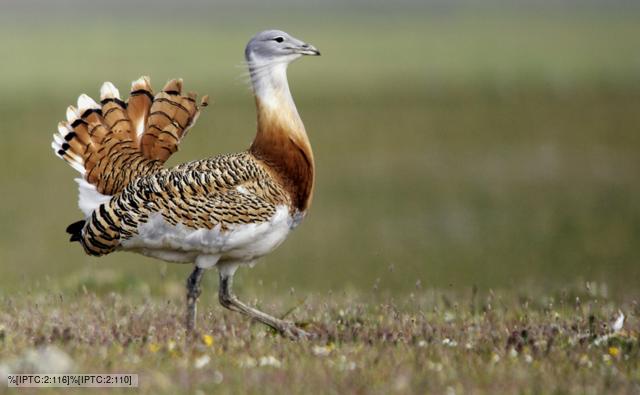Scientific name: Oris tarda
A higher clade it's part of: Gruiformes (cranes & allies)
Conservation status: Vulnerable
Current range: Spotty areas of grassland and steppe across Eurasia in the band of latitude stretching from Gibraltar to southern England, plus a small area in Morocco across from the Straits.
The Great Bustard is the heaviest extant flying bird (also most sexually dimorphic in size). Well...depending on what you mean by "heaviest". It could mean (1) heaviest on average, (2) heaviest maximum in the range of sizes normally reached, or (3) heaviest record. The male Great Bustard's stats for those are (1) 21.3-29.8 lb (9.65-13.5 kg), (2) 40 lb (18 kg), and (3) 46 lb (21 kg). They're rivaled by their relative the Kori Bustard, whose weight surpasses it in (1) 30 lb (13.5 kg), ties it in (2) 40 lb (18 kg), and is beaten by it in (3) 44 lb (20 kg). For the record, I'm ignoring unconfirmed records because it's
ridiculous how much those can be exaggerated, even when the teller
doesn't mean to. The way our memories and perception work is annoying
sometimes...
Like many Gruiformes, these birds display to attract mates. Because they're ground birds, they perform in leks much like the more local-to-Calontir prairie chickens.
I haven't seen any bustards in Sarmatian art, but they co-existed on the Russian steppes, so it's unlikely they never encountered them. Scytho-Sarmatian art tends to focus on mammals rather than birds–eagles being the exception–so it's not really surprising that they wouldn't depict them.
 |
| www.bbc.co.uk - Male demonstrating part of the display. |
Conservation status: Vulnerable
Current range: Spotty areas of grassland and steppe across Eurasia in the band of latitude stretching from Gibraltar to southern England, plus a small area in Morocco across from the Straits.
 |
| Birding in Portugal has a display/fighting video (skip to 1:05 for the bustards) and some fantastic photographs, including this one. It demonstrates the sexual dimorphism between the female (top) and male (bottom). And yes...she is doing what you think she's doing. |
Like many Gruiformes, these birds display to attract mates. Because they're ground birds, they perform in leks much like the more local-to-Calontir prairie chickens.
I haven't seen any bustards in Sarmatian art, but they co-existed on the Russian steppes, so it's unlikely they never encountered them. Scytho-Sarmatian art tends to focus on mammals rather than birds–eagles being the exception–so it's not really surprising that they wouldn't depict them.
I'm seeing birds that look like chicken-hawk hybrids, act like giant chickens on the ground, and hunt like hawks in the air. Link's worst nightmare?
ReplyDeleteHa! Link need not fear; they mostly run around on the ground eating plants and insects.
DeleteHey--it's off the subject of steppe wildlife, but I found a website you might be interested in. Well, actually I learned about it from a person I follow on Pinterest, who pins a lot of Scythian and Sarmatian stuff (Leyla Merdente--I think she's Ossetian). Anyway, it's the website of the Archaeological and Museum Reserve in Tanais, Russia. They have exhibits on the Greeks, Scythians, and Sarmatians. The whole website's in Russian, but there are some fantastic pictures, especially of clothing reconstructions:
ReplyDeletehttp://www.museum-tanais.ru/muzey-istoricheskogo-kostyuma-104
Because I know you have so much time on your hands. :)
Good thing I have a webpage translating plugin for my browser!
DeleteBookmarked for later. :) Thanks!